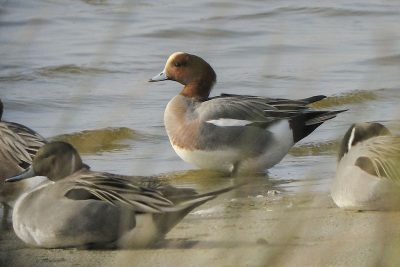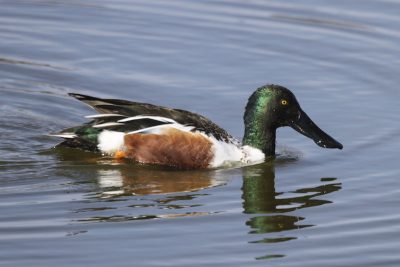Reprinted from the Outer Banks Voice. Each month Jeff Lewis, an expert on birds and bird-watching, writes an article on the subject for the publication.
What does December mean to you? Christmas shopping, decorations, time off work, time with family, candy canes, tinsel and Santa Claus?
Supporter Spotlight

To serious birders, December also means waterfowl and Christmas bird counts.
Pea Island National Wildlife Refuge in December is magical.
The three refuge impoundments are full of ducks, geese and swans (and lots of other birds, too).
To best observe these birds, get there very early for good viewing conditions – sunrise is about right – and, starting at the north end of North Pond, work your way south, stopping in spots safe from fast-moving traffic to scan the ponds. Safe locations include the small parking lot at the north end, the wide, sandy pull-off by the photo blind and the paved parking lot at the visitor center.
Heading south, the shoulder is just wide enough about midway at New Field, the middle impoundment, for safe parking.
Supporter Spotlight
Then, there is a nice location at the north end of South Pond to park. Driving south from there, look carefully before pulling off because some spots are firm and others are soft sand. After that, with the sun higher in the sky, I usually turn around, drive back to North Pond and walk the north and south dikes, taking advantage of the observation platforms. A good spotting scope is a real asset.
You should see lots of ducks and swans, Canada geese and maybe snow geese, and lots of other birds.
American white pelicans are common now at Pea Island in the winter, and several species of shorebirds should be visible on any mud flats that are exposed. Wading birds – herons, egret and ibis – should be present, as well. American coots should be easy to find in their big rafts and common gallinule is a possibility, especially at the north end of North Pond, a little ways back toward the west.

Puddle ducks, or dabblers, that are common in December include mallard, American black duck, northern shoveler, gadwall, green-winged teal, American wigeon and northern pintail. You may also find a blue-winged teal or two. Be sure to carefully search flocks of American wigeon for Eurasian wigeon; the drakes will have a red head, creamy yellow forehead and a gray back and sides (see photo).
Diving ducks that are usually present include redhead, sometimes in huge rafts; ring-necked duck; greater scaup; lesser scaup; red-breasted merganser; hooded merganser; bufflehead; and ruddy duck. Canvasbacks can sometimes be spotted in the redhead flocks. Some years, one or more common mergansers are present. The diving ducks are often farther back in the impoundments and may require a spotting scope for good views.
If the ducks suddenly take off, check the skies. This often means that a peregrine falcon or bald eagle is nearby.
While tundra swans are usually scattered everywhere, the best spot for snow geese is often at the south end of South Pond, fairly close to the road. Search through them for the smaller, stubby-billed Ross’s goose.
If you want to add a few more waterfowl to your day’s list, scan the ocean. Black and surf scoters can often be spotted, and a white-winged scoter is possible, too. You will usually see common and red-throated loons, as well, and maybe a few horned grebes.
Inside Oregon Inlet, near the Bonner Bridge, you may also find scoters and even a common eider, long-tailed duck or a harlequin duck, if you’re lucky. At the time of this writing, a rare female king eider had been seen, first near the Bonner Bridge, then in North Pond. Hopefully, it will stick around for a while.
Another great waterfowl location within range of Outer Bankers is Lake Mattamuskeet, about an hour drive from Manteo. The lake itself has been declining in productivity, but the impoundments at Lake Landing and especially Wildlife Drive should be super this winter. Cold, windy days are usually best.
Other good spots to try include the pond at the Bodie Island Lighthouse, the Alligator River Refuge, the Pocosin Lakes Refuge, which is about a two-hour drive west, and Mackay Island Refuge, to the north. Try to time your visit to Mackay when they have their periodic Open Roads Days. These locations are more rewarding if you have a spotting scope.
The National Audubon Society’s Christmas Bird Counts started in 1900 and are an annual citizen-science tradition in this country.
Count areas are circles with a 15-mile diameter, and they remain the same, year after year. A compiler is in charge of organizing his or her circle, which involves picking a date, recruiting participant birders, providing count sheets and arranging a meeting place afterward to compile the data.
The participants record the species seen as well as the actual numbers – basically taking an inventory of the birds found in his or her section of the circle. The birds are identified by sight or sound, so a good knowledge of birds is desirable. Inexperienced people who wish to learn are paired up with the more experienced birders.

The information gathered is used to determine winter bird distribution, population health, population trends, migration routes, habitat use and even clues to the effects of climate change on populations.
In our area are the following counts: Kitty Hawk, Bodie/Pea, Hatteras, Ocracoke, Alligator River and Mattamuskeet. For more information, check out the Audubon website and follow the links. Locations of the circles and contact information for the compilers in your area should be available.
Woodland, including edges, birds to look for in December include winter wren, blue-headed vireo, red-breasted nuthatch, brown creeper, yellow-bellied sapsucker, eastern phoebe, white-throated sparrow, fox sparrow, hermit thrush, ruby-crowned and golden-crowned kinglet, American goldfinch, purple finch and pine siskin.
Also, keep an eye out for cooper’s and sharp-shinned hawks. Many of these birds will visit the birdfeeders or water features of people living in wooded habitats.
In open brushy or field habitats look for dark-eyed junco, savannah, song, swamp, Lincoln’s, white-crowned, chipping and field sparrows, along with house wren, eastern phoebe, northern harrier and American kestrel, in addition to the year-round residents.
When large flocks of blackbirds are found, look for the rare, but annual, yellow-headed blackbird.
In salt or brackish marsh habitats, you may find Nelson’s, saltmarsh and seaside sparrows and clapper, king, Virginia rail and Sora. Look here also for northern harriers flying low over the marsh. At dusk, you may spot a short-eared owl.
Good birding!
This story is provided courtesy of the Outer Banks Voice, a digital newspaper covering the Outer Banks. Coastal Review Online is partnering with the Voice to provide readers with more environmental and lifestyle stories of interest about our coast.







